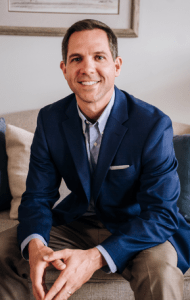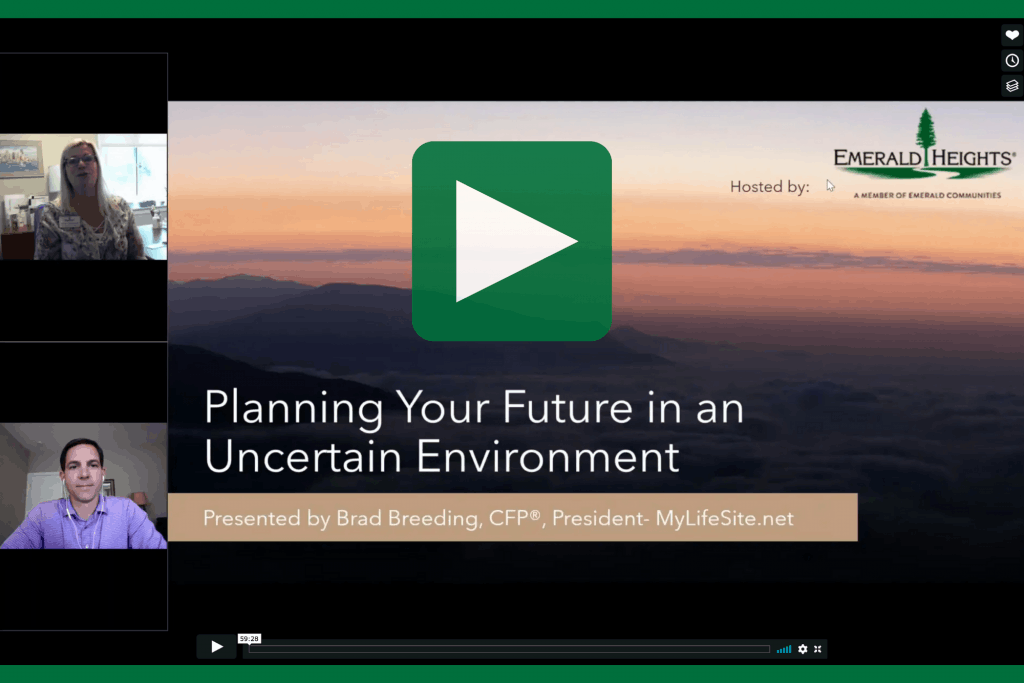Planning Your Future During a Time of Uncertainty
July 17, 2020Industry expert Brad Breeding offers his views on retirement planning and choosing a senior living community, even during the pandemic.
If you hoped to attend the webinar with guest speaker Brad Breeding that Emerald Heights hosted on June 2 but were unable to — or if you did join us and would like a recap — we’re happy to share the main takeaways about planning for your future for you here.
For those of you who aren’t familiar with Brad, he’s a nationally recognized expert in the senior living industry. As a former financial adviser, he continues to maintain his designation as a certified financial planner. He’s also an author and the co-founder and president of MyLifeSite.net
‘Planning Your Future in an Uncertain Environment’
Brad kicked off his presentation with an overview of how you can stay grounded in a time like we’re experiencing now when there’s a lot of turmoil around us and it’s easy to feel as if we’ve been knocked off our feet. In fact, he shared one of his favorite quotations, by Mike Tyson:
“Everyone has a plan until they get punched.”
When you have three components in place, he said it’s easier to ride out the uncertainty. That’s not to suggest that you’ll be in the same place afterward, but you most likely won’t feel as though you’ve been on a rollercoaster ride to get there.
What are the three vital components for holding on to your financial confidence in turbulent times? Perspective, objective(s), and a plan.
Perspective
Brad cautioned that unless you keep a given situation in perspective, you run the risk of letting your emotions drive the decisions you make — and that can be costly in the long run.
To make his point, he recommended taking a moment to consider how you felt about your financial situation a few years ago, say, in 2016. He said most people, when asked about this, would probably say they felt pretty secure, having recovered from the Great Recession of the late 2000s.
Brad then showed a series of graphs depicting fluctuations in various stock market indicators. These included the Wilshire 5000 Total Market Index, as well as price/earnings ratios and average dividend yields for the S&P 500. He pointed out that while the U.S. stock market did indeed take a dip in mid-March, at the lowest point it was still substantially better than where it was in 2016 or early 2017. That’s because the market has been on a historic 10-year bull run, he said, and to put the recent decline into perspective is to see that the market was essentially overpriced and has recently been “pulling back” from an all-time high. When stock prices dropped a few months ago, investors saw an opportunity to buy, causing the market to rebound.
Housing Market Conditions
He then turned to a discussion of the housing market, which of course is of interest to those of you who are contemplating a move. Like the stock market, he said the housing market has also been priced at or near an all-time high. He noted that market conditions vary widely by region and by market segment. So it’s best to talk with a real estate professional who knows your local market well.
In general, he said the projections are for housing prices to drop 2% to 4% in the next six to 12 months. But, he pointed out, they dropped an average of about 27% during the Great Recession. So even if there’s an 8% or 10% drop in prices over the next year, that’s still only about a third of the decrease seen then. Again, it’s all about keeping the situation in perspective.
Inventories are still tight in many markets, Brad said. But that could change if a lot of people end up being forced to sell. He said if you’re waiting until the current environment stabilizes before putting your house on the market, it’s important to define what exactly you’re waiting for. If you simply keep waiting without setting any parameters, you may inadvertently wind up waiting until conditions have worsened.
He also said the record-low rates we’re seeing now make the prospect of buying a house particularly attractive for those who have the means.
Objective(s)
One common mistake people make when planning for retirement, according to Brad, is not having clear objectives.
He provided examples of primary objectives — to never run out of money to live comfortably, or to leave a specific amount of money to your family or to charity — as well as secondary objectives — to not be a burden on your family, or to protect against the cost of long-term care.
Establishing your retirement objectives makes planning much easier, he said. Without them, you can’t measure the effect of market changes on your retirement plan, and that means you won’t be able to make the necessary adjustments to ensure you can live the way you want.
A Plan
Brad recommended keeping your retirement plan simple. Basically, add up your monthly or annual income from stable sources other than investments (e.g., Social Security, pension, certain types of annuities, and rental income). Then, add up your living expenses, both discretionary and non-discretionary. Subtracting your total living expenses from your non-investment income will either give you a surplus or a shortfall.
Most retirees, he noted, will have a shortfall. That’s where savings and investment income come into play. If you can cover the shortfall and still meet your objectives, then you’re in good shape. And that’s why clarifying your objectives is so important. If you don’t define them, it’s really hard to plan for retirement.
And that’s another point Brad brought up: You shouldn’t just be planning for retirement. You should be planning through retirement. That brings us to his next topic.
Planning Your Future Beyond Your Finances
There’s obviously more to retirement than just the financial aspect. Brad suggested thinking more broadly and considering what some of your concerns might be. Here are some of the most common concerns people face in retirement:
- Having a serious health problem
- Being a burden to one’s family
- Running out of money to live comfortably
- Being lonely
- Having nothing to leave one’s children or grandchildren
- Not having a purpose
Having a complete retirement plan that takes your specific concerns into account will lead to greater peace of mind. Brad proposed a retirement plan that includes four elements:
- Finances
- Preventive Health/Wellness
- A Post-Health Event Plan
- Your Family
He explained how the concerns listed above fit into these four categories, and how the place you choose to live can play a significant role in all four areas.
Your Retirement Living Options
When you start looking at senior living communities, it can be easy to feel overwhelmed by the many types available. We can help you understand the terminology and the various kinds of financial arrangements so that you can make the best choice for your specific situation.
In the webinar, Brad said there are four “tradeoffs” to consider when evaluating and comparing retirement communities:
- The cost of living in the community today, when you don’t have any major health concerns
- The hospitality services and amenities the community offers
- The types and quality of care available, should you need it later on
- The cost of available care, including when you will pay for it (upfront or when it’s provided)
As a Life Care community, Emerald Heights provides the full spectrum of care, including assisted living, skilled nursing, and memory support. And as a Type A Life Care community, we offer predictable costs for healthcare over time. Many people find that combination of features highly appealing because it lets them live with confidence, knowing they have a plan in place for the future.
You can find out more about what a Life Care community is and see our resident schedule of fees here.
Related Article — Life Care: What It Is. What It Could Mean to You.
Retirement Living in the Age of COVID-19
Before wrapping up the webinar, Brad spoke a little about what he has observed while interacting with different senior communities over the last few months. He said the news has focused on the worst cases — which often have occurred in freestanding nursing homes, some of which lacked adequate personal protective equipment, were poorly managed, or possibly both. In some instances, patients with COVID-19 were transferred to nursing homes from hospitals.
With regard to independent living communities, Brad said he has found that residents have more flexibility as far as the lockdown policies go, and thus they are able to get outside for hikes and bike rides. He also has noticed that the residents in these communities really appreciate the extra efforts staff members are making to keep everyone as safe as possible, such as delivering meals right to their door. And they’ve been especially grateful for the connections they’ve been able to maintain with other residents through Zoom sessions (e.g., cooking, exercise, and educational classes) and virtual social events like “block parties” and happy hours. He said they feel better protected where they are than they would outside the community, and they’re motivated to “get through this together.”
Considering “Aging in Place”?
For people who are considering “aging in place,” Brad said the usual challenges are amplified right now because of the coronavirus. For example, having one or more caregivers coming and going increases the risk of exposure. Plus, professional caregivers are in shorter supply these days. With the recent stay-at-home requirements, there also may be a greater sense of isolation for older adults who are living alone. And should there be a need for hospitalization, say, for injuries resulting from a fall, that scenario also involves increased risk of exposure. Living in a senior community like Emerald Heights greatly diminishes those risks.
Brad said there is a bright spot to consider with regard to the COVID-19 outbreak. He said the lessons we’re all learning now will be helpful in the future.
Want to Know More?
If you’d like to watch the complete webinar, you can view it here. If you’d like to receive a copy of Brad’s book, What’s the Deal with Retirement Communities?, let us know and we’ll send one to you at no charge. Just send an email with your request to info@emeraldheights.com.
Learn more about Life Care at Emerald Heights and what we’re doing to provide peace of mind during the pandemic.
Related Article — Offering Care & Peace Of Mind During Crisis
Ready to talk about the options you have at Emerald Heights? We invite you to schedule a call with one of our marketing associates. Fill out a contact form below and we’ll be in touch!




